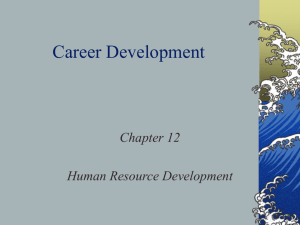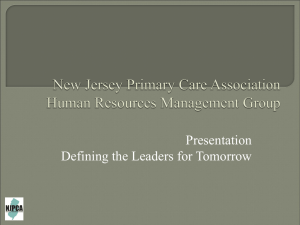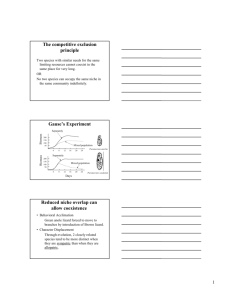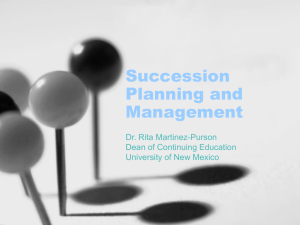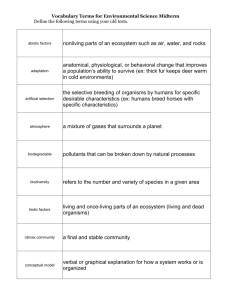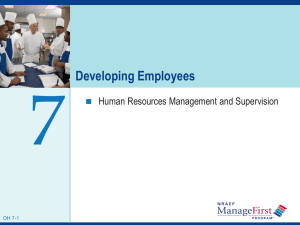Chapter 7 Professional Development Programs
advertisement
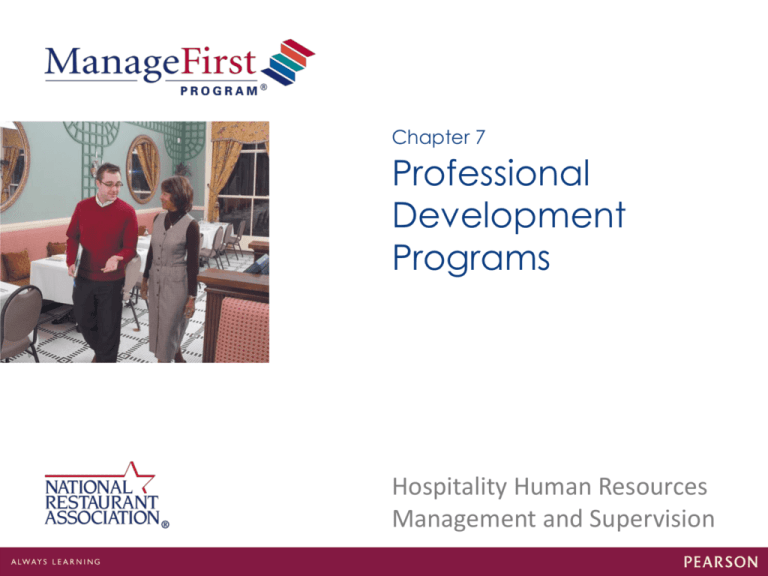
Chapter 7 Professional Development Programs Hospitality Human Resources Management and Supervision Learning Objectives After completing this chapter, you should be able to: • Explain the importance of professional development. • Describe basic professional development strategies. • Identify procedures for professional development planning meetings. • Provide information about professional development programs for managers. • Explain three commonly used professional development methods. Learning Objectives continued: After completing this chapter, you should be able to: • Identify other professional development methods. • Describe basic procedures for developing succession plans. Chapter 7 Professional Development Programs IMPORTANCE OF PROFESSIONAL DEVELOPMENT Overview of Professional Development Responsibilities for Professional Development Chapter 7 Professional Development Programs PROFESSIONAL DEVELOPMENT STRATEGIES Chapter 7 Professional Development Programs Establish Goals While Considering the Budget Select Development Methods Evaluate, Approve, and Implement Plan Chapter 7 Professional Development Programs Chapter 7 Professional Development Programs Monitor Progress and Evaluate Plan Celebrate and Maintain Success Chapter 7 Professional Development Programs PROFESSIONAL DEVELOPMENT PLANNING MEETINGS Meeting Preparation Start the Meeting Set Developmental Goals Chapter 7 Professional Development Programs THE MANAGER’S PROFESSIONAL DEVELOPMENT PROGRAM Chapter 7 Professional Development Programs Chapter 7 Professional Development Programs Continuous Improvement Networking Chapter 7 Professional Development Programs PROFESSIONAL DEVELOPMENT METHODS Cross-Training Delegation Mentoring Chapter 7 Professional Development Programs Chapter 7 Professional Development Programs Other Professional Development Methods Chapter 7 Professional Development Programs Chapter 7 Professional Development Programs DEVELOPING SUCCESSION PLANS Chapter 7 Professional Development Programs - Summary 1. Explain the importance of professional development. • Professional development involves the experience, training, and education provided to employees to help them do their jobs and prepare them for other positions. • The same basic activities can be used for employees and managers. • Knowledge or skill gaps are apparent when staff need improved skills to be more productive, are assigned a new task, or want to qualify for different jobs. • The operation should provide professional development. • The immediate manager should help employees plan their program. • The employee is most responsible for achieving goals. Chapter 7 Professional Development Programs - Summary 2. Describe basic professional development strategies. • The first step in professional development is to establish goals, which should focus on the operation’s needs first. • The budget is an important concern, and specific, measurable goals are required. • The second step is to identify methods of acquiring the knowledge and skills. • Some opportunities are likely available in the operation. • External alternatives may include colleges, professional associations, and books, video, and computer-based training. • Professional development plans consider goals, time frames, activities, evaluation, and progress checks. • The final steps are to evaluate, approve, and implement the plan. • Progress should be monitored to determine if goals are being achieved and whether corrective actions are necessary. Chapter 7 Professional Development Programs - Summary 2. Describe basic professional development strategies continued… • Successful completion should be celebrated and recorded in the employee file. • A summary should be made to help plan future activities. Chapter 7 Professional Development Programs - Summary 3. Identify procedures for professional development planning meetings. • Professional development planning should be held separate from an employee’s performance appraisal. • The manager should establish the agenda, meeting location, and time frame, and inform the employee. • All information related to developmental needs should be gathered, and an outline will be helpful to organize the information collected. • The manager can begin by asking about needs, concerns, and interests to determine starting points. • Developmental goals, related to learning or improving specified knowledge or skills, should be established. • Managers should work closely with the employee to develop a program that best meets the needs of the operation and the employee. Chapter 7 Professional Development Programs - Summary 4. Provide information about professional development programs for managers. • Advancement goals for managers may involve long-term planning with numerous activities. • Details about advancement plans should be written down, and reasonable completion dates should be mutually agreed on. • Alternatives include apprenticeship, coaching, informal learning, job rotation, and on-the-job training. • Other possibilities include external training, self-study, special projects, and team assignments. • Continuous improvement can be achieved through certification programs and organization memberships. • Managers should network to build relationships that help with career advancement. • Networking also keeps managers current with industry trends and can provide contacts for resolving problems. Chapter 7 Professional Development Programs - Summary 5. Explain three commonly used professional development methods. • Cross-training allows staff members to learn a related job, often by working closely with an employee in the job. • Delegation is working through others to complete a project, and it shares authority and entrusts employees to accomplish assigned tasks. • Mentoring is a process in which an experienced employee provides advice to less experienced employees about the job, establishment, and profession. Chapter 7 Professional Development Programs - Summary 6. Identify other professional development methods. • Other common development methods include apprenticeships, coaching, informal learning, job rotation, and on-the-job training. • Other possibilities include outside training and education, self-study, special projects, and temporary assignments. Chapter 7 Professional Development Programs - Summary 7. Describe basic procedures for developing succession plans. • Succession planning can help organizations ensure that employees will be recruited for and prepared to fill key positions when they become vacant. • First, job descriptions should be reviewed to determine which positions to include. • Then the plan should be developed with help from tools including the organization chart, job descriptions, and job specifications. • Training programs should be developed and employees selected. • Current employees may be selected for some positions and external contacts may be used to recruit others. • Trainees should be evaluated and training activities revised as necessary, and the succession plan should be evaluated periodically. Chapter 7 Professional Development Programs Key Terms: Certification The process through which an organization grants recognition to an individual who meets certain established criteria. Cross-training Training in which an employee learns how to do work normally done by someone in a different position. Delegation A process of working with and through others to complete a task or project; it shares authority and entrusts employees to accomplish the tasks assigned to them. Developmental goal A description of the knowledge and skills that need to be gained or improved on to eliminate or reduce an employee’s knowledge and skills gap. Knowledge or skill gap A difference between the knowledge or skills a manager or employee already has and those that are needed to do the job. Chapter 7 Professional Development Programs Key Terms continued: Mentoring A process in which an experienced employee provides advice to less-experienced employees about concerns relating to the job, establishment, and profession. On-the-job training (OJT) A one-on-one approach to training conducted at the work site. Professional development Any experience, training, and education provided to help employees do their current jobs better and prepare them for other positions. Succession planning A process used by many organizations to ensure that employees will be recruited for and prepared to fill key positions when they become vacant. Chapter 7 Professional Development Programs Chapter Images Chapter 7 Professional Development Programs Chapter Images continued



